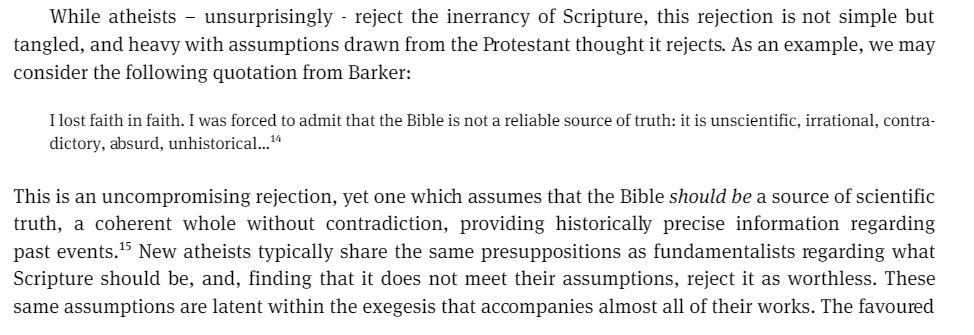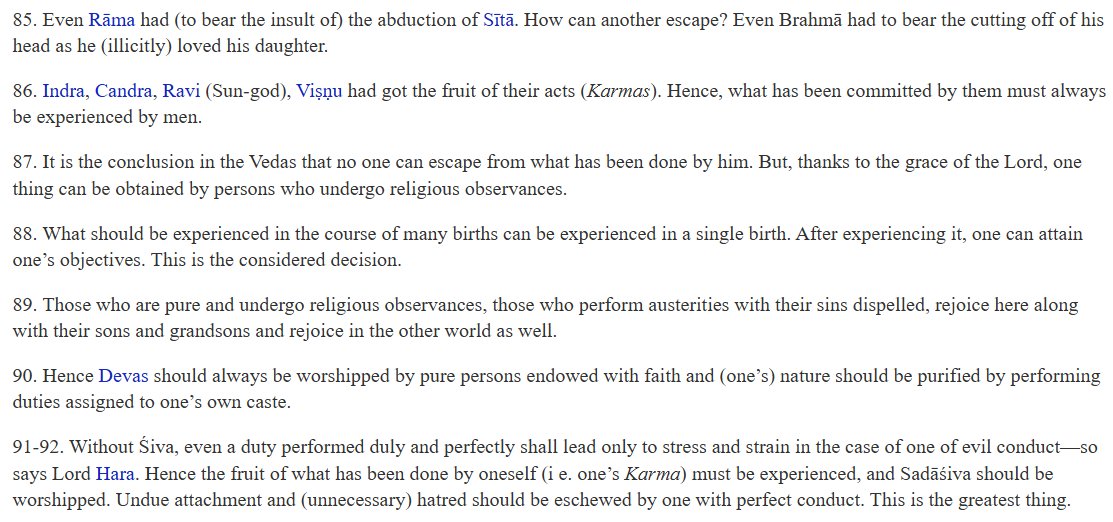Read a comment to the effect that using the term “myths” means that the person has no faith & should be committed to an asylum. By that logic, many great AcAryas would be worthy of being committed for holding that myths reflect certain truths outside historical time & space.
Poor @Dauhshanti was getting trolled by low-IQ, hare-brained pests. Hence my comment.
A huge consequence of technological egalitarianism (equal access to technology/resources) is that individuals of very mediocre abilities watch a few videos of famous Hindutva tweeple, get all woke & go around giving their useless opinions on complex theological issues.
You have never put in the hours to do the hard work. You don’t even possess a basic vocabulary of the matters on which you abuse others. You can’t even say the names of relevant works of AcAryas since all you know is a few hot-off-the-press titles written in the last 5-10 years.
Unpopular opinion: Forming opinions & arguments on Hindu theological issues should never be a democratic, free-for-all process. There should be a diversity of opinions, yes; but from a small group of intelligent people. Unfortunately, we can’t enforce that here.
Are you more Hindu than the great kumArila-bhaTTa who said that the indra-ahalyA AkhyAna should be seen symbolically such that indra stands for the sun with ahalyA representing the night that disappears (lIyate/लीयते) by day (ahani) (i.e. ravished by the rising sun)??
Are you more Hindu than the great shaivAcArya rAmakaNTha of 900+ CE kAshmIram, who wrote that paramashiva doesn't actually bear a moon on his head, being beyond form or that the paurANika AkhyAnas (killing andhakAsura, etc) should be understood for the subtle truths they teach?++
Are you more Hindu than the venerable traditional scholar, Hindu revivalist & anti-missionary, intellectual warrior, shrI ARumukha nAvalar of Jaffna, who taught that the skanda-vaLLi story should be understood in light of its tattva-rahasya & not literally??++
1. The truth of paurANika kathas has nothing to do with literal occurrence in historical time. Sure, great bhaktas will speak as if they occurred in such a manner. That is to induce a certain rasa in oneself & others.++
2. Nowhere in dharma is the literal understanding of paurANika kathas as actual occurrences in historical time in some corner of the universe deemed as some fundamental article of faith. That is your own assumption, due to your sheer lack of reading/training.
3. By privileging the materialist definition of truth as "actual, historical occurrence", you have completely ceded the ground to your enemies. Both Xtians & their earliest opponents (the post-Enlightenment atheist freaks) were literally 2 sides of the same coin++
3'Contd: Both based their respective stances on the historical reality of the bible. The Xtians attempted to prove the accuracy of their bible by demonstrating how historical evidence matches with biblical testimony. Atheists tried to show how it did not match.++
3'Contd: Don't get sucked into the game. I am not saying that matters of historical value can't be found in our texts. Of course they can & we must do all we can to uncover our history. But we do not need "actual occurrence" to extract the truth of purANa-kathas.
The idea that historical actuality of scripture is essential in order for scriptures/traditions to have any worth/value is shared by both abrahamisms & modern atheism.
By Liam Jerrold Fraser in "The Secret Sympathy: New Atheism, Protestant Fundamentalism, and Evolution":
By Liam Jerrold Fraser in "The Secret Sympathy: New Atheism, Protestant Fundamentalism, and Evolution":

Since a few people have misunderstood my thread and many more are likely to misunderstand later, let me surmise the several conclusions from this thread & side-threads:
1. Take any divya-shAstram (divine shAstra). Is it "true"? 1-word answer: YES. It applies to all categories:
1. Descriptive accounts of events/persons
2. vidhi/pratiSedha: Injunction/prohibitions with specified fruits for adherence/violation
3. Description of tattva-viSaya
1. Descriptive accounts of events/persons
2. vidhi/pratiSedha: Injunction/prohibitions with specified fruits for adherence/violation
3. Description of tattva-viSaya
2. If that shAstra is giving us certain accounts of devas, humans, etc, does it need historical actuality to be true? No, it does NOT NEED it all.
Can it be true without any historical evidence? YES.
Can it be true even while contradicting supposed evidence? YES.
Can it be true without any historical evidence? YES.
Can it be true even while contradicting supposed evidence? YES.
3. Main purpose of a divya-shAstra is to do 2 things:
a. Give us injunctions/prohibitions whose observance/non-observance bears fruits in a non-worldly (a-laukika) manner.
b. Give us, descriptively, tattva-viSayas which are utterly a-laukika & can't be known in an empirical way.
a. Give us injunctions/prohibitions whose observance/non-observance bears fruits in a non-worldly (a-laukika) manner.
b. Give us, descriptively, tattva-viSayas which are utterly a-laukika & can't be known in an empirical way.
4. AcAryas got the importance of reading a shAstra properly. Merely saying, "Oh I easily believe all these things as they are; you dare reflect on this? You faithless intellectual" is no display of shraddhA. It is lazy thoughtlessness & vain virtue-signalling disguised as piety.+
5. When a great man from a hoary guru-parampara, who lived & taught more than a 1000 years ago, explains painstakingly why purANa stories (shiva entrancing the wives of daruka-vana sages, killing andhaka, etc) are to be understood non-literally, you can either give up or read.
6. Saying snarky things like, "Oh I can believe these things happening literally anyway; what is all this highfalutin stuff?" does not make you a "simple-minded bhakta". It makes you an arrogant person who puts down great gurus without putting in the effort to understand them.
7. Now, some nuances. Take "symbolic interpretation" & take the 3 categories mentioned in point 1 above.
1st category: Symbolic reading does NOT necessarily have to displace a literal reading of accounts/events. Both literal & symbolic readings can coexist. No problem.+
1st category: Symbolic reading does NOT necessarily have to displace a literal reading of accounts/events. Both literal & symbolic readings can coexist. No problem.+
7. Cont'd:
Classic example of co-existence: rAmAyaNa-vyAkhyAna: The great teacher, piLLai-lokAcArya, reads many rAmAyaNa events in light of an inner meaning in his shrI-vacana-bhUSaNam. But this doesn't imply denial of literal occurrence within this world.+
Classic example of co-existence: rAmAyaNa-vyAkhyAna: The great teacher, piLLai-lokAcArya, reads many rAmAyaNa events in light of an inner meaning in his shrI-vacana-bhUSaNam. But this doesn't imply denial of literal occurrence within this world.+
8. 2nd Category: Symbolic meaning cannot wish away or invalidate the literal performance of ritual injunctions (i.e. vedic sacrifices), unless it can be established that the literal carrying out of the vidhi will result in a serious contradiction or absurdity.++
8'Cont'd:
Injunctions are there to be acted upon when heard. Symbolic interpretation cannot destroy the potency of an injunction to convey that literal meaning. Some may ask, "What is this literal meaning you are speaking of?"+
Injunctions are there to be acted upon when heard. Symbolic interpretation cannot destroy the potency of an injunction to convey that literal meaning. Some may ask, "What is this literal meaning you are speaking of?"+
8'Cont'd:
There is a core principle in interpretation called, "रूढिर्योगमपहरति", accepted by all mainstream traditions/teachers.
Meaning: The रूढि: (conventional usage) of a word will set aside the यौगिक meaning (Etymological meaning formed by union of a word's components)
There is a core principle in interpretation called, "रूढिर्योगमपहरति", accepted by all mainstream traditions/teachers.
Meaning: The रूढि: (conventional usage) of a word will set aside the यौगिक meaning (Etymological meaning formed by union of a word's components)
8'Cont'd:
Thus, one cannot wish away the conventional meanings of words like pashu, vapA (omentum/fat), etc simply because they are displeased with the literal sense. One can choose not to implement the literal sense, sure. But one cannot deny the literal sense of the injunction.
Thus, one cannot wish away the conventional meanings of words like pashu, vapA (omentum/fat), etc simply because they are displeased with the literal sense. One can choose not to implement the literal sense, sure. But one cannot deny the literal sense of the injunction.
9. 2nd Category: Sometimes, there may be contradictions in the same shAstra's ritual injunctions (vidhis). So, a skilled guru may then rely on the concepts of "arthavAda", "prashaMsA" (praise) & ninda (condemnation) to resolve it.++
9. Cont'd: Sometimes, in order to highlight the merit of a particular method of doing something, the shAstra may put down another method which it had praised earlier.++
10. 1st/3rd Category contradictions: Sometimes, there may be contradictions between a tattva-viSaya & an account of events or there may be contradictions between 2 descriptive passages discussing tattva-viSayas.++
10. Cont'd: Will not delve into detailed examples as they can be technical. The teacher will sometimes reconcile two contradictory descriptive, tattva-viSaya passages with the help of the surrounding context. Or, he may utilize a higher "meta", tattva-viSaya to resolve it.
10. For example, as to the question of where a certain category of souls are situated, different Agamas will give different bhuvanas (Worlds). The teacher briefly notes that the category of souls in question possesses omnipresence & so the precise location doesn't really matter.
11. Sometimes, certain purANa-kathas have to be explained in a non-literal fashion. Why? Say that a shAstra teaches you paramashiva exists beyond time (kAla) & form (rUpa). How would one then understand kathas where shiva is with a particularized form & acting within time??++
11 Cont'd. So, andhaka-vadhaH (slaying of andhaka) is interpreted as the destruction of mala (the impurity which blinds a soul to its true nature. There are many more examples, but I will stop here.
12. Interpretation of texts is a very complex task. There is no single way to look at it. There is no one conclusion. "Historicity is good", "Historicity is bad", "Symbolic meaning is good for everything". There is a case by case approach for all of this.
13. We should NOT use "historicity" to undermine our shAstras/sampradAyas. We should NOT limit our definition of "truth" to "occurrence in historical time". Having said that, we can use both historical & symbolic readings to enhance our appreciation of certain matters.//End
• • •
Missing some Tweet in this thread? You can try to
force a refresh













